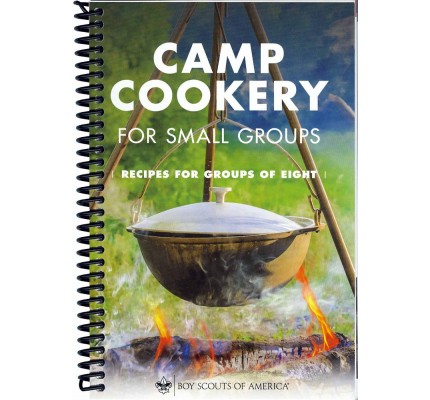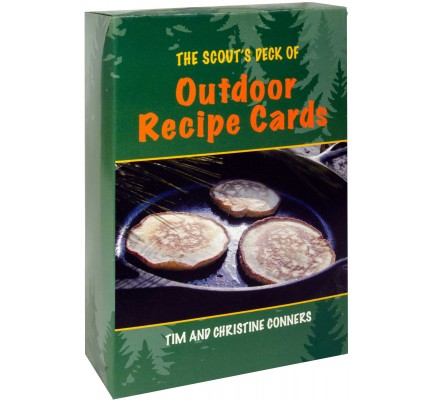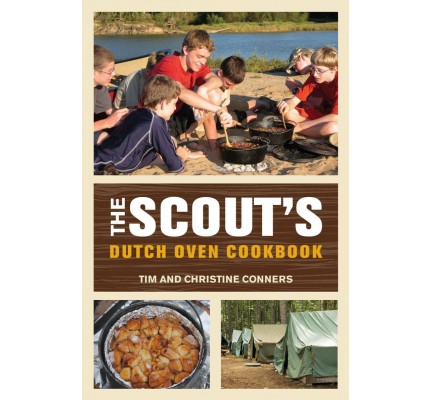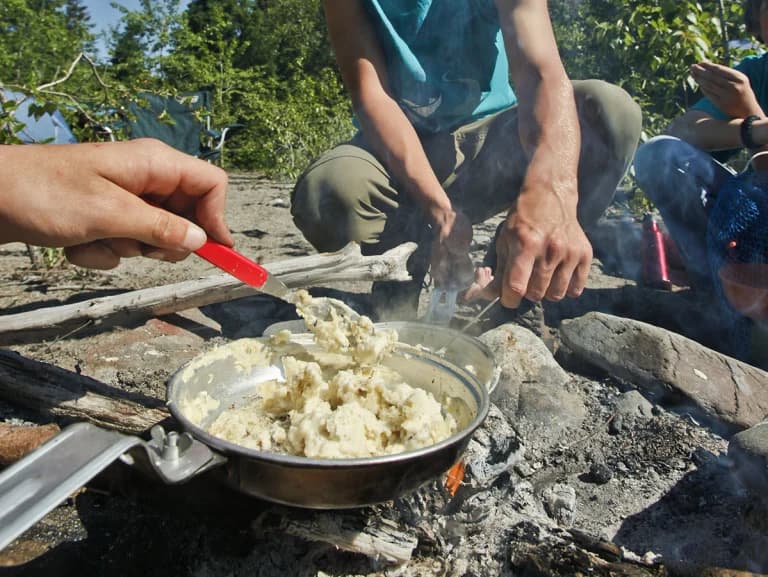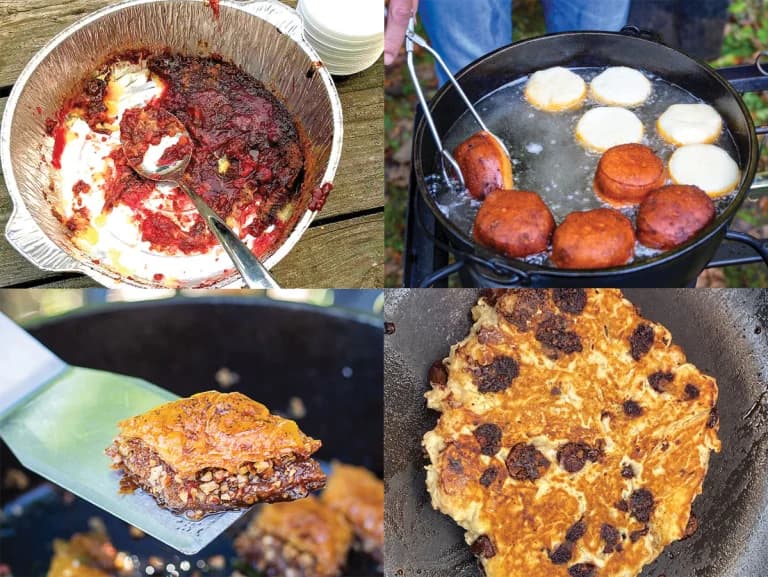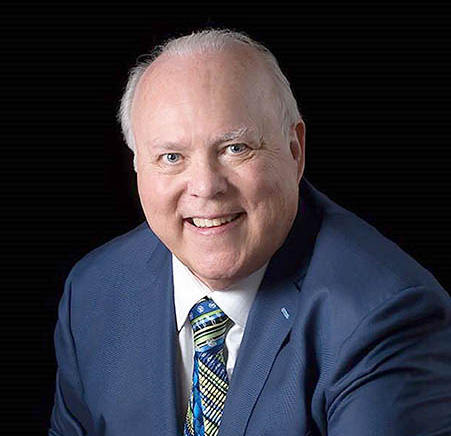Cooking Merit Badge
 Eagle Required
Eagle Required
Cooking
Merit Badge
Scouting America Merit Badge Hub
Scouting America
Merit Badge Hub
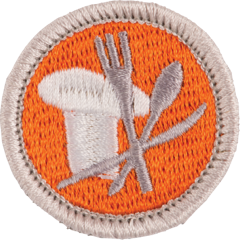
Requirement Updates 2025
This Merit Badge’s Requirements have recently been updated in 2025 Scouting America Requirements (33216). Please read more about “Requirements” on the Merit Badge Hub homepage. The previous version of the Merit Badge requirements can be found in Scoutbook.
Cooking Merit Badge Overview
The Cooking merit badge introduces principles of cooking that can be used both at home or in the outdoors. Scouts who earn this badge will learn about food safety, nutritional guidelines, meal planning, and methods of food preparation, and will review the variety of culinary (or cooking) careers available.
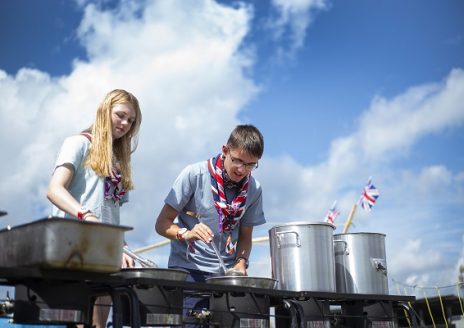
Cooking Merit Badge Requirements
The previous version of the Merit Badge requirements can be found in Scoutbook
The requirements will be fed dynamically using the scout book integration
1.
Health and safety. Do the following:
- (a) Explain to your counselor the most likely hazards you may encounter while participating in cooking activities and what you should do to anticipate, help prevent, mitigate, and respond to these hazards.
- (b) Show that you know first aid for and how to prevent injuries or illnesses that could occur while preparing meals and eating, including burns and scalds, cuts, choking, and allergic reactions.
- (c) Describe how meat, fish, chicken, eggs, dairy products, and fresh vegetables should be stored, transported, and properly prepared for cooking. Explain how to prevent cross-contamination.
- (d) Discuss with your counselor food allergies, food intolerance, and food-related illnesses and diseases. Explain why someone who handles or prepares food needs to be aware of these concerns.
- (e) Discuss with your counselor why reading food labels is important. Explain how to identify common allergens such as peanuts, tree nuts, milk, eggs, wheat, soy, and shellfish.
2.
Nutrition. Do the following:
- (a)
Using the MyPlate food guide or the current USDA nutrition model, give five examples for EACH of the following food groups, the recommended number of daily servings, and the recommended serving size:
(1) Fruits
(2) Vegetables
(3) Grains
(4) Proteins
(5) Dairy
- (b) Explain why you should limit your intake of oils and sugars.
- (c) Track your daily level of activity and your daily caloric need based on your activity for five days. Then, based on the MyPlate food guide, discuss with your counselor an appropriate meal plan for yourself for one day.
- (d) Discuss your current eating habits with your counselor and what you can do to eat healthier, based on the MyPlate food guide.
- (e) Discuss the following food label terms: calorie, fat, saturated fat, trans fat, cholesterol, sodium, carbohydrate, dietary fiber, sugar, protein. Explain how to calculate total carbohydrates and nutritional values for two servings, based on the serving size specified on the label.
3.
Cooking Basics. Do the following:
- (a) Discuss the following cooking methods. For each one, describe the equipment needed, how temperature control is maintained, and name at least one food that can be cooked using that method: baking, boiling, broiling, pan frying, simmering, microwaving, air frying, grilling, foil cooking, Dutch oven.
- (b) Discuss the benefits of using a camp stove on an outing vs. a charcoal or wood fire.
- (c) Describe for your counselor how to manage your time when preparing a meal so components for each course are ready to serve at the correct time.
- (d) Explain and give examples of how taste, texture, and smell impact what we eat.
Note: The meals prepared for Cooking merit badge requirements 4, 5, and 6 will count only toward fulfilling those requirements and will not count toward rank advancement or other merit badges. Meals prepared for rank advancement or other merit badges may not count toward the Cooking merit badge. You must not repeat any menus for meals actually prepared or cooked in requirements 4, 5, and 6.
4.
Cooking at Home. Do the following:
- (a) Using the MyPlate food guide or the current USDA nutrition model, plan menus for three full days of meals (three breakfasts, three lunches, and three dinners) plus one dessert. Your menus should include enough to feed yourself and at least one adult, keeping in mind any special needs (such as food allergies) and how you keep your foods safe and free from cross-contamination. List the equipment and utensils needed to prepare and serve these meals.
- (b) Find recipes for each meal. Create a shopping list for your meals showing the amount of food needed to prepare for the number of people you will serve. Determine the cost for each meal.
- (c) Share and discuss your meal plan and shopping list with your counselor.
- (d) Using at least five of the 10 cooking methods from requirement 3, prepare and serve yourself and at least one adult (parent, family member, guardian, or other responsible adult) one breakfast, one lunch, one dinner, and one dessert from the meals you planned. The meals for requirement 4 may be prepared on different days, and they need not be prepared consecutively. Those served need not be the same for all meals.
- (e) Time your cooking to have each meal ready to serve at the proper time. Have an adult verify the preparation of the meal to your counselor.
- (f) After each meal, ask a person you served to evaluate the meal on presentation and taste, then evaluate your own meal. Discuss what you learned with your counselor, including any adjustments that could have improved or enhanced your meals. Tell how planning and preparation help ensure a successful meal.
5.
Camp Cooking. Do the following:
- (a) Using the MyPlate food guide or the current USDA nutrition model, plan a menu that includes four meals, one snack, and one dessert for your patrol (or a similar size group of up to eight youth, including you) on a camping trip. These four meals must include two breakfasts, one lunch, and one dinner. Additionally, you must plan one snack and one dessert. Your menus should include enough food for each person, keeping in mind any special needs (such as food allergies) and how you keep your foods safe and free from cross-contamination. List the equipment and utensils needed to prepare and serve these meals.
- (b) Find or create recipes for the four meals, the snack, and the dessert you have planned. Adjust menu items in the recipes for the number to be served. Create a shopping list and budget to determine the per-person cost.
- (c) Share and discuss your menu plans and shopping list with your counselor.
- (d) In the outdoors, using your menu plans and recipes for this requirement, cook two of the four meals you planned using either a camp stove OR backpacking stove. Use a skillet OR a Dutch oven over campfire coals for the third meal, and cook the fourth meal in a foil pack OR on a skewer. Serve all of these meals to your patrol or a group of youth.
- (e) In the outdoors, using your menu plans and recipes for this requirement, prepare one snack and one dessert. Serve both of these to your patrol or a group of youth.**
- (f) After each meal, have those you served evaluate the meal on presentation and taste, and then evaluate your own meal. Discuss what you learned with your counselor, including any adjustments that could have improved or enhanced your meals. Tell how planning and preparation help ensure successful outdoor cooking.
- (g) Lead the clean-up of equipment, utensils, and the cooking site thoroughly after each meal. Properly store or dispose unused ingredients, leftover food, dishwater and garbage.
- (h) Discuss how you followed the Leave No Trace Seven Principles and the Outdoor Code when preparing your meals.
6.
Trail and backpacking meals. Do the following:
- (a) Using the MyPlate food guide or the current USDA nutrition model, plan a day of meals for trail hiking or backpacking that includes one breakfast, one lunch, one dinner, and one snack. These meals must consider weight, not require refrigeration and are to be consumed by three to five people (including you). List the equipment and utensils needed to prepare and serve these meals.
- (b) Create a shopping list for your meals, showing the amount of food needed to prepare and serve each meal, and the cost for each meal.
- (c) Share and discuss your menu and shopping list with your counselor. Your plan must include how to repackage foods for your hike or backpacking trip to eliminate as much bulk, weight, and garbage as possible.
- (d) While on a trail hike or backpacking trip, prepare and serve two meals and a snack from the menu planned for this requirement. At least one of those meals must be cooked over a fire, or an approved trail stove (with proper supervision).**
- (e) After each meal, have those you served evaluate the meal on presentation and taste, then evaluate your own meal. Discuss what you learned with your counselor, including any adjustments that could have improved or enhanced your meals. Tell how planning and preparation help ensure successful trail hiking or backpacking meals.
- (f) Explain to your counselor how you should divide the food and cooking supplies among the patrol in order to share the load. Discuss how to properly clean the cooking area and store your food to protect it from animals.
7.
Careers and Hobbies. Do ONE of the following:
- (a) Identify three career opportunities that would use skills and knowledge in cooking. Pick one and research the training, education, certification requirements, experience, and expenses associated with entering the field. Research the prospects for employment, starting salary, advancement opportunities and career goals associated with this career. Discuss what you learned with your counselor and whether you might be interested in this career.
- (b) Identify how you might use the skills and knowledge in cooking to pursue a personal hobby or healthy lifestyle. Research the additional training required, expenses, and affiliation with organizations that would help you maximize the enjoyment and benefit you might gain from it. Discuss what you learned with your counselor and share what short-term and long-term goals you might have if you pursued this.
* The meals for requirement 4 may be prepared on different days, and they need not be prepared consecutively. The requirement calls for Scouts to plan, prepare, and serve one breakfast, one lunch, and one dinner to at least one adult; those served need not be the same for all meals.
** Where local regulations do not allow you to build a fire, the counselor may adjust the requirement to meet the law. The meals in requirements 5 and 6 may be prepared for different trips and need not be prepared consecutively. Scouts working on this badge in summer camp should take into consideration foods that can be obtained at the camp commissary.

Get the Cooking Merit Badge Pamphlet
Scouts use the Cooking Digital Merit Badge Pamphlet to earn the Cooking merit badge, which introduces principles of cooking that can be used both at home or in the outdoors.
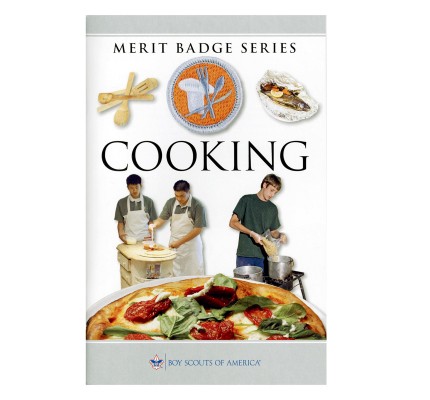
Shop Cooking Merit Badge Products
As the exclusive retailer of Scouting America, 35% of every Scout Shop purchase supports the future of Scouting.
Discover more about "Cooking"

Mike Holcombe has seen Scouts who were afraid to stir soup. Chip Goss has watched Scouts turn rice pilaf into charcoal, despite his frequent reminders

When Avery Moore isn’t volunteering as Scoutmaster of Troop 11 in Rocky Mount, N.C., you can find him helping out at a local pediatric burn survivor aftercare program. It was during a virtual meeting for the latter that he discovered a need that could be met by the former.
“Since COVID-19 has impacted the globe the way it has,” Moore says, “the burn units have been bombarded with pediatric burn patients, all of them with a similar story: They were trying to cook when no one was around, and something went horribly wrong.”
Then, a debate arose with an answer that would be obvious for anyone involved in Scouting.
“Very simply, they just wanted to know if there were any youth-serving organizations that teach life skills to youth like cooking, first aid, safety, fire prevention … and the list could go on,” Moore says.

Chow time is one of our favorite things about camping. Whether it’s a steamy pot of cheesy pasta or warm biscuits fresh out of the Dutch oven, good food

It’s important to eat balanced meals, but sometimes it’s nice to satisfy your sweet tooth. Here are four tasty recipes to try.
Have a favorite dessert recipe? Send it to us!
OWASIPPE SOUP
Last summer at Owasippe Scout Reservation in Michigan, Matthew Hanson with Troop 41 of Glen Ellyn, Illinois, won a cooking contest with this recipe.
Ingredients
One 20-ounce can crushed pineapple in juice
One 21-oz. can cherry pie filling
1 box chocolate cake mix
¾ cup butter, melted
Directions
Spread the crushed pineapple and its juice into a 12-inch Dutch oven. Spread the cherry pie filling on top of the crushed pineapple. Evenly spread cake mix over both layers, and then pour melted butter on top. Cook in Dutch oven 40-45 minutes with about 15 coals on top and 10 on the bottom. Serve.
CAVE DOUGHNUTS
After exploring the Sullivan Cave in Indiana, Scouts with Troop 797 of Utica, Illinois, made this tasty treat.
Ingredients
1 gallon vegetable oil
Pre-made biscuits
Powdered sugar
Cupcake icing in a can
Directions
Fill a pot two-thirds full with oil. Heat it until dough turns lightly brown when it’s placed in; this might take a couple of tests. Place balls of biscuit dough in the oil and let them cook for about 2 minutes, flipping after about 1 minute. Then remove the cooked dough with tongs and roll them in the powdered sugar. Inject the doughnuts with the icing. Serve
DUTCH OVEN BAKLAVA
Scouts with Troop 1911 of Missoula, Montana, cook this treat annually at summer camp.
Ingredients
24 sheets phyllo dough (a special thin dough, also in stores as filo and fillo)
1 cup butter, melted
1½ cups finely chopped pecans
2 tablespoons sugar
1 teaspoon cinnamon
Lemon honey syrup:
1½ cups sugar
¾ cup water
½ teaspoon lemon juice
1 tablespoon honey
Directions
Prepare honey syrup by combining all ingredients and bringing to a boil for 1 minute. Set aside to cool.
Melt the butter. Mix pecans, sugar and cinnamon; set aside. Generously butter the bottom of a 12-inch Dutch oven. Lay 1 sheet of phyllo dough in the bottom of the Dutch oven. Butter the top, beginning at the edges and working toward the center. Repeat this step until you have placed eight sheets of phyllo dough, buttering each layer.
Sprinkle half of the nut mixture evenly over the phyllo dough.
Place eight more sheets of phyllo dough on top of nut mixture, buttering between each layer. Sprinkle the remaining nut mixture on top.
Repeat with eight more sheets of phyllo dough, buttering each layer. Drizzle any remaining butter on the top.
Cut into diamond-shaped pieces without cutting through the bottom layer of phyllo dough. Place the lid on the Dutch oven and bake at 350 degrees (eight coals on bottom, 16 on top) for 35-40 minutes or until lightly golden. Remove from heat and pour the honey syrup over the baklava. Serve.
S’MORES PANCAKES
The Scouts of Troop 129 of Anchorage, Alaska, make this breakfast meal the first morning of summer camp every year.
Ingredients (feeds 4)
2 cups pancake mix
About 1½ cups water
1 sleeve of graham crackers, crushed
2 cups chocolate chips
1 container marshmallow fluff
Directions
Preheat a pan on medium-high heat and grease with butter. Combine the pancake mix with water, and then stir in the crushed graham crackers and chocolate chips. Place mixture on the pan in desired size and shape. Cook until golden brown on both sides.
Remove from the pan and top with marshmallow fluff and any additional toppings of your choosing. Serve.


